Berengaria Of Navarre
 From Nwe
From Nwe | Berengaria of Navarre | |
|---|---|
| Queen consort of the English | |
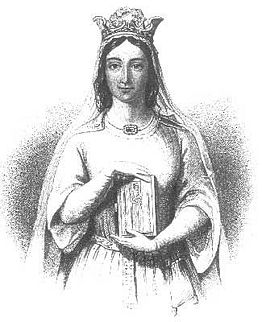 |
|
| Consort | 12 May 1191 – 6 April 1199 |
| Consort to | Richard I of England |
| Titles | |
| The Queen Dowager The Queen Infanta Berengaria of Navarre |
|
| Royal House | House of Plantagenet House of Jiménez |
| Father | Sancho VI of Navarre |
| Mother | Sancha of Castile |
| Born | c. 1165-1170 |
| Died | 23 December 1230 (aged 59–65) |
Berengaria of Navarre (Spanish: Berenguela, French: Bérengère) (c. 1165 – December 23, 1230) was queen consort to King Richard I, the Lionheart. She was the eldest daughter of Sancho VI of Navarre and Sancha of Castile, and was also related to royalty in France and England.
Taking her name from the Navarre region in the north of Spain bordering on the French lands of Aquitaine, Berengaria was called "prudent and elegant" by chroniclers who saw her, and she was well educated. She and Richard met around 1176, when he was still a prince attending a tournament held by her father, and it was as a result of this meeting that they became betrothed and because she brought a large dowry.
She married Richard when at Limassol, Cyprus while he was on his way to the Third Crusade. However, she spent very little time with him during their eight-year marriage, and they had no children. She became a widow when she was about 34 and Richard was 42, and never remarried. She was later known as, "the only English queen to never set foot in England."
After Richard's death, Berengaria suffered poverty as a result of lack of support from Richard's brother, King John. She fought for her dower rights, utilizing her influence with the popes Honorius III and Innocent III and her famous mother-in-law, Eleanor of Aquitaine. When John was defeated in Normandy, Philip II of France exchanged her properties there for the county of Maine. Only after John's death did she receive the rest of what was due her from his son, Henry III. In her final days, she ruled in Maine and established a Cistercian monastery at l'Epau in Le Mans, living in the abbey from 1204 until her death in 1230.
Life
Background
Berengaria was the eldest daughter of King Sancho VI of Navarre and Sancha of Castile. Her maternal grandparents were Alfonso VII of León and Berenguela of Barcelona. She was a fourth generation descendant of Rodrigo Díaz de Vivar, better known as El Cid. She was also closely related to royalty in France and England. Her brother, Sancho el Fuerte, succeeded his father as king of León and her sister, Blanche, married Thibaut of Champagne, who was the grandson of Eleanor of Aquitaine and Louis VII of France. Blanche and Tibaut's son succeeded Sancho VII as king of Navarre.
Marriage
Bengaria and Richard met years before their marriage at a tournament, but a match between them was not yet contemplated. Richard was betrothed to Alys, Countess of the Vexin, the sister of King Philip II of France. Alys, however, became the mistress of Richard's own father, King Henry II, and was allegedly the mother of Henry's illegitimate child. Richard thus terminated his betrothal to Alys, and his mother, Eleanor of Aquitaine arranged a new match with Berengaria.
After their betrothal, Berengaria traveled with Eleanor to meet him while he traveled on the Third Crusade shortly after his coronation. The two women had a long and difficult journey to catch up with him. They arrived in Sicily during Lent, when the marriage could not take place. They were joined by Richard's sister Joan Plantaganet, the widowed queen of William II of Sicily.
En route from there to the Holy Land, the ship carrying Berengaria and Joan went aground off the coast of Cyprus, and they were nearly captured by the island's renegade ruler, Isaac Komnenus. Richard came to their rescue, conquered the island, overthrew Komnenus and took control of Cyprus as a base for his crusade. The island proved immensely valuable in keeping the Frankish kingdoms in the Holy Land viable for another century. Berengaria finally married Richard on May 12, 1191, in the Chapel of St. George at Limassol, Cyprus.
Queen consort
Despite this romantic beginning, whether the marriage was ever even consummated is a matter of debate. Berengaria brought to the marriage a great fortune and the lands of Navarre, which bordered Eleanor's lands of Aquitaine. Many have argued that Richard was much more interested in lands and war than marriage, and that only the influence of Eleanor brought the union about. Richard's sexual orientation has been hotly debated in recent years, with revisionist historians claiming that Richard was a homosexual, and others depicting him as a notorious womanizer who found Berengaria too pious for his lascivious tastes. Some sources have recorded him having at least one bastard son, Philip of Cognac (d. c. 1211). It would be strange indeed for a ruler of Richard's standing not to attempt to sire a legitimate heir. In any case, the couple had no children, and either infertility or lack of time together may be the simplest explanation for this.
After the wedding, Berengaria followed Richard to the Holy Land, where she and Joan stayed in Acre. When the crusade failed, she left with Joan for France in September 1192. Richard, with what was left of his army, planned to go to France to protect his Angevin lands from the attempt of Philip II and his brother John, both of whom had designs on his throne.
Berengaria did not see Richard for three years. Returning by sea, she and Joan stopped in Rome to pay their respects to pope Innocent III, remaining there for six months as his guests. They were then conducted to Marseilles, accompanied by Alfonso II of Aragon. They then progressed through Provence, and next on to Poitou, conducted by Raymond of St. Gilles, don of the count of Toulouse—whom Joanna subsequently married. They finally reached Aquitaine ahead of Richard, only to learn of Richard's capture and imprisonment in Germany. Berengaria remained in Aquitaine during Richard's imprisonment (1192-1194), helping her mother-in-law Eleanor to raise the enormous ransom needed (150,000 marks/65,000 pounds in silver) to free him. After his release, Berengaria remained in France while Richard returned to England, where he had to regain the territory that had been lost to Philip II during the regency of John.
During this period, Richard faced criticism from the Church for living separately from his queen and was even ordered by Pope Celestine III to reunite with Berengaria and to show fidelity to her. When a severe illness nearly cost him his life, Richard publicly repented and rejoined Berengaria for Christmas at Poitiers in 1195, taking her to church every week while there. Their time together did not last long, however, as Richard left again for more battles against Philip II and his own rebellious vassals. He gave his greatest attention for the next two years to building the huge castle, Chateau Gaillard at Les Andelys in Normandy, from which he could defend his lands. At this point, Richard named John as his successor in England.
Discouraged by Richard's long absences, Benengaria retired to an obscure castle near Angers, where she heard the news of Richard's death. He died on April 6, 1199, aged 42, as a result of a wound incurred while besieging the castle of a vassal who had rebelled. While some say that Berengaria was present at his deathbed, others report that even though she was only a day away she did not come to his side and did not participate in his funeral.
Dowager queen
Berengaria never visited England during Richard's lifetime. However, it should be noted that during the entirety of their marriage, Richard himself spent just three months there. She may have gone to England in the years following his death, however. If so, the traditional description of her as "the only English queen never to set foot in the country" could still be technically true, as she did not visit England during the time she was Richard's consort.
However, Berengaria certainly sent envoys to England several times. Her main concern was the pension she was due as dowager queen, which King John was not paying her. She lived in near poverty and for a time had to take refuge at her sister Blanche's court in Champagne, in northern France. Blanche had married Thibaut of Champagne, grandson of Eleanor of Aquitaine and Louis VII of France. Blanche and Thibaut's son succeeded Sancho VII as king of Navarre. Berengaria had been a witness at her sister's marriage, and may even have helped in arranging it. Blanche and her son treated Berengaria as a close relation and helped her to acquire the land she needed to found her lifelong dream of building a Cistercian monastery at l'Epau in Le Mans, Maine.
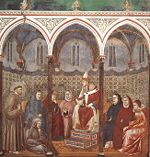
Berengaria now entered into a long struggle to recover her dower lands, which were in France. She was also due to receive Eleanor's lands in England, Normandy, and Poitou after the great queen's death. Her champions in this struggle were Pope Innocent III and his successor, Honorius III. Finally, in 1220, after threats and even excommunications, papal power prevailed, and Berengaria received a pension from England. Still, John did not completely pay his sister-in-law what was owed her, which was more than than £4000 when he died. However, during the reign of his son Henry III of England, her payments were made as they were supposed to be, bringing the English monarchy again into harmony with the pope.
Ruler and patron
As a result of King John losing Normandy to France, Phillip II made haste to seize Berengaria's lands there, but she claimed them as rightfully hers as dowager queen. In exchange for these lands, she accepted from him the county of Maine. Thereafter, she lived and ruled in Maine, in the city of Le Mans.
There, Berengaria entered the convent life, and founded the abbey of l'Epau in Le Mans. However, she remained directly involved in ruling the area around Le Mans, and her authority over the city was recognized by the French crown. She was also involved in struggles with the local bishop over corrupt practices in his church and on jurisdictional issues. She arbitrated disputes and appointed functionaries. She again fell into conflict with the local church when she tried to levy taxes. In a letter from Pope Honorius III to the abbot of St. Genevieve and two Paris deans, when Berengaria and a "large multitude of people" came to the church for Palm Sunday services, the bishop and the chapter refused them entry and shut the doors in their face "to the confusion, injustice/injury, and scandal of many."[1]
She lived in the abbey from 1204 until she died in 1230, and was buried there.
Legacy
Like many queen consorts, Berengaria of Navarre, does not figure boldly in the history of the English royalty, especially because she did not even visit England while she was queen consort and also she did not produce an heir. No one knows whether she was barren, whether Richard simply was not interested, or whether they became estranged for other reasons. After her husband's death, she showed great strength and tenacity in her struggles over 20 years to gain her rightful dower inheritance from King John, and then from his son Henry III.
Ultimately, she found happiness and peace when she was able to build the l'Epau Cistercian monastery in Le Mans, which had been a lifelong wish. Her governing of the county of Maine was fair and competent, and she showed determination and strength in her battles with the local clergy.
In the twentieth century, Berengaria's effigy was moved from the abbey to the Cathedral of St. Julien in Le Mans. She is still revered in that city as "Dame of Le Mans," and perhaps this is the most fitting epitaph, rather than one that tries to link her with Navarresse or English royalty. Here was where she eventually found peace and an opportunity to serve her God-and where her memory as a strong, brave, and fair ruler still lives. The plaque reads:
This mausoleum dedicated to Berengaria, most serene Queen of the English and foundress of this monastery, was restored and relocated in this most solemn place and in it were placed the bones which were found in the ancient grave AD 17 May 1672. It was taken from the abbey of Pietas Dei and replaced in the Cathedral Church 2nd December 1821.[2]
A skeleton thought to be hers was discovered in 1960 during the restoration of the abbey.
In fiction
The story of Richard and Berengaria's marriage is fictionalized in the 1935 film, The Crusades, starring Loretta Young and Henry Wilcoxon, and was a prominent feature of the 1960s British television series, Richard the Lionheart, but both versions were highly romanticized and are not reliable sources of information about the queen.
Novels featuring Berengaria include:
- The Passionate Brood by Margaret Campbell Barnes
- The Heart Of The Lion by Jean Plaidy
- Queen Without a Country by Rachel Bard
- My Lord Brother the Lionheart by Molly Costain Haycraft
- Shield of Three Lions and Banners of Gold, by Pamela Kaufman
- The Lute Player by Norah Lofts
- Standard of Honor by Jack Whyte
- Wyrd by Sue Gough
- The Talisman by Sir Walter Scott
| English royalty | ||
|---|---|---|
| Preceded by: Eleanor of Aquitaine |
Queen consort of the English 12 May 1191 – 6 April 1199 |
Succeeded by: Isabella of Angoulême |
Notes
- ↑ Columbia University, Armchair Travel Co. Ltd. Retrieved January 24, 2009.
- ↑ CTV, Berengaria: In Search of Richard the Lionheart´s Queen.
References
ISBN links support NWE through referral fees
- Bard, Rachel. Queen Without A Country. Literary Network Press, 2001. ISBN 978-0971033382
- Bloss, C. A. Heroines of the Crusades. Rochester, Wanzer, Beardsley & co., 1853. OCLC 4567877
- Gillingham, John . Richard I. New Haven: Yale University Press, 1999. ISBN 978-0300079128
- Lofts, Norah. Queens of England. Garden City, NY: Doubleday, 1977. ISBN 978-0385127806
- Sauers, Victoria. Lionhearted Queen: Berengaria of Navarre. Philadelphia: Blue Bear Press, 2000. ISBN 978-0966629422
- Strickland, Agnes. Lives of the Queens of England from the Norman Conquest: With Anecdotes of their Courts. Philadelphia: Lea & Blanchard, 1841. OCLC 8830518
- Trindade, Ann. Berengaria: In Search of Richard's Queen. 1999. ISBN 1851824340
- Weir, Alison. Britain's Royal Families: A Complete Genealogy. London: The Bodley Head, 1999. ISBN 009953973X
External links
All links retrieved January 20, 2022.
Credits
New World Encyclopedia writers and editors rewrote and completed the Wikipedia article in accordance with New World Encyclopedia standards. This article abides by terms of the Creative Commons CC-by-sa 3.0 License (CC-by-sa), which may be used and disseminated with proper attribution. Credit is due under the terms of this license that can reference both the New World Encyclopedia contributors and the selfless volunteer contributors of the Wikimedia Foundation. To cite this article click here for a list of acceptable citing formats.The history of earlier contributions by wikipedians is accessible to researchers here:
The history of this article since it was imported to New World Encyclopedia:
Note: Some restrictions may apply to use of individual images which are separately licensed.
↧ Download as ZWI file | Last modified: 02/04/2023 07:48:41 | 15 views
☰ Source: https://www.newworldencyclopedia.org/entry/Berengaria_of_Navarre | License: CC BY-SA 3.0
 ZWI signed:
ZWI signed:


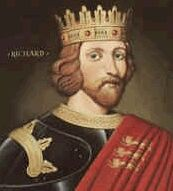
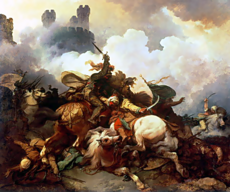
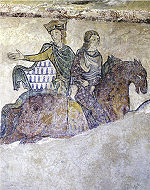

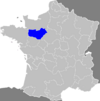
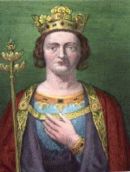

 KSF
KSF